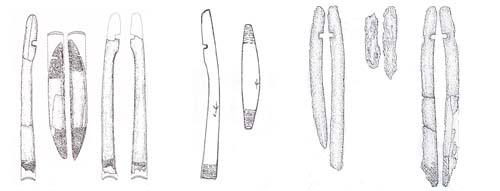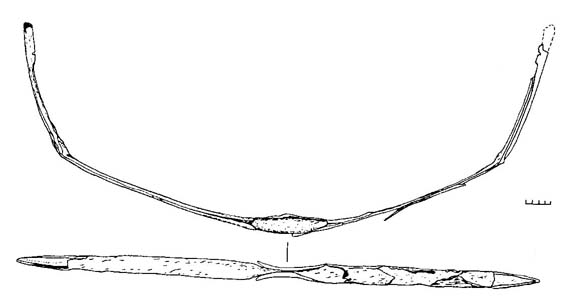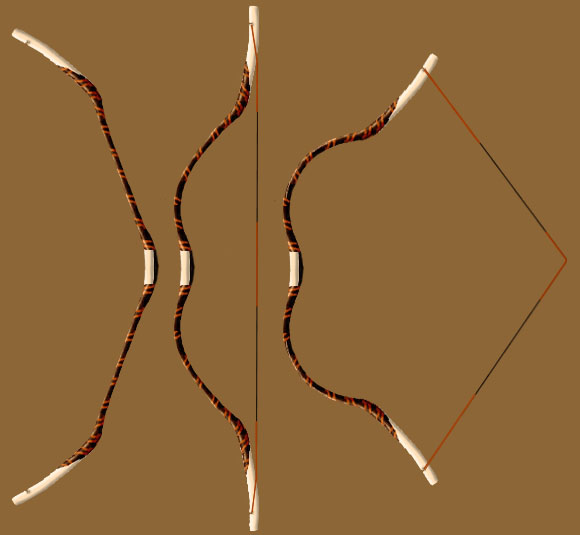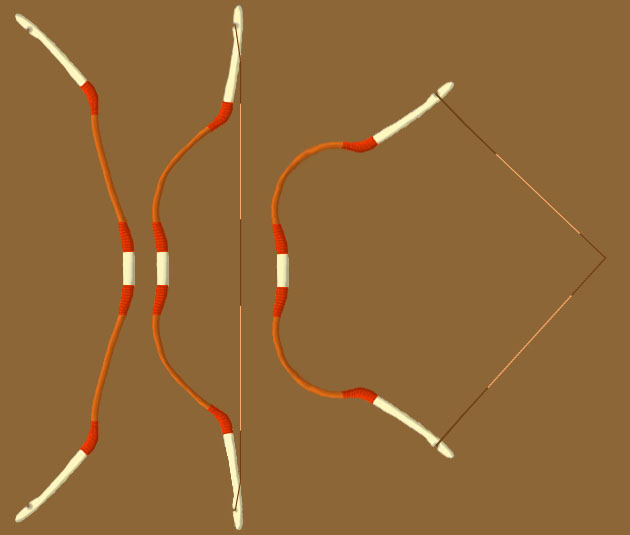
Bone plates found in 10th century Hungarian graves.
The Magyar Bow
In the 1920s a lot of 10th century graves were found. Among the stirrups, sabres and other things, archeologists found long and narrow bone plates. Nobody knew what they were until Cs. Sebestyen Karoly realized that their function was to reinforce the grip and siyahs or horns (szarv in Hungarian) of the bow.

Bone plates found in 10th century Hungarian graves.
After this recognition it became obvious that the Hungarian bow was an Asian reflex bow. Sebestyen then tried to define the exact form of the bow, which was especially difficult since at this period no drawings of the graves were made, therefore the original position of the plates was not known. So his reconstruction had to be patterned after Asian bows still in use in that time. Finally he decided that the unstrung bow's limbs must have been straight between the horn and the grip. The angle of the limbs at the grip could be seen on the middle bone plates, while the angle between the horn and the limb is a result of a calculation which is based on the assumption that the string touches the horns only at the notches.
Cs. Sebestyen Karoly's reconstruction of the magyar bow
Sebestyen's writings caught the attention of Fabian Gyula, a teacher of the Godollo
Agricultural University. He had been dealing with archery for a long time then,
and he became especially fascinated with the Magyar bow. Sebestyen's theoretical
reconstruction answered the basic questions; but Fabian wanted to know more. He
thought that only experimental archeology could answer his questions, so he decided
to build a working replica of the bow.
In the end he built more than a dozen bows. He found that the best material for the core of the bow was maple. He used deer sinews for the backing, horn of Hungarian gray cattle for the belly, and deer antler for the bone plates. Most of his results supported the reconstruction of Sebestyen. The only difference between their reconstructions was the form of the unstrung bow. Fabian built much less reflexed bows, thereby reducing the risk of limb twist, but also reducing the efficiency of the bow.

Fabian Gyula's reconstruction of the magyar bow.
For a long time it couldn't be decided which form was correct. Now, some more recent discoveries show that Sebestyen's drawings are closer to reality. In Moshchevaya Balka (Northern Caucasus) two almost intact bows (along with other well preserved objects) were found in a cemetery that is dated to the first half of the 8th century. At that time, Hungarian tribes occupied a nearby area and were part of the Khazar empire which included the Northern Caucasus. Bone plates of these two bows and other equipment found in the cemetery are very closely related to those found in Hungarian cemeteries. The conclusion that Magyar bows were similar in form is quite obvious.

Bow from a cemetery at Moshchevaya Balka, 8th century.
In 1987 archeologist Revesz Laszlo excavated three cemeteries near Karos (North-Eastern
Hungary). Among several very significant finds he found the usual narrow bone plates.
He was able to measure the original position of the plates only in two graves.

Grave no.14 of the 2nd cemetery at Karos.

Grave no.60 of the 2nd cemetery at Karos.
Revesz asked Szollosy Gabor to make a reconstruction of the bows, which he did. However, no graphical reconstruction has been published, so I have decided to do it myself. The size and position of the bone plates were given. I chose a draw length of 76cm (30"). This is a long Asian draw if we consider that the height of the average Hungarian male in the 10th century was about 160cm (5'4").

Reconstruction of the bow from grave no.14 of the 2nd cemetery at Karos.
Distance of notches, unstrung: 125cm (4'2"), strung: 135cm (4'6").
Draw length: 76cm (30")

Reconstruction of the bow from grave no.60 of the 2nd cemetery at Karos.
Distance of notches, unstrung: 112cm (3'9"), strung: 114cm (3'9").
Draw length: 76cm (30")